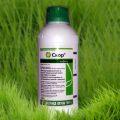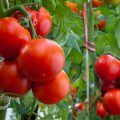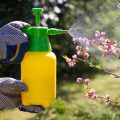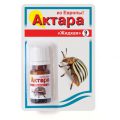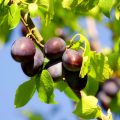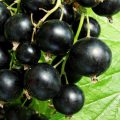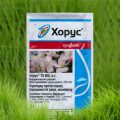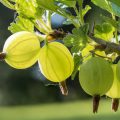Urea - the most popular fertilizer among farmers, gardeners, oenologist. The use of urea in the garden help to cope with the shortage of nitrogen, which leads to poor development of kidney, bad harvest, dropping early foliage.
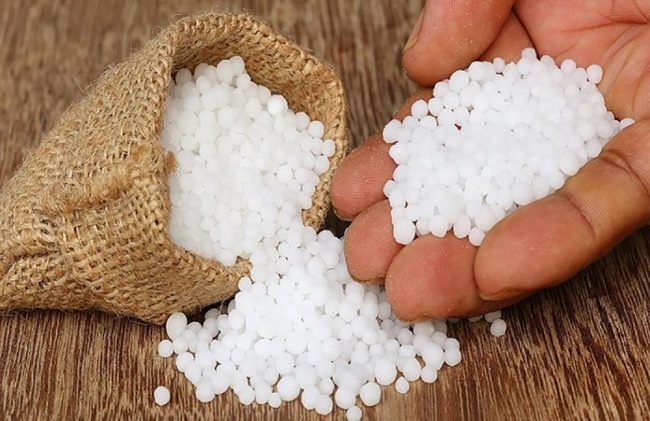
How to use urea, not to harm the plants and get a good harvest in the garden and the garden?
What is urea, and why it is needed
Urea (Anyway urea) - fertilizer, containing a large amount of pure nitrogen. In agriculture, this organic compound is used for feeding different cultures, to encourage growth and high yield.
Urea is the nitrogenous fertilizer, and a lack of nitrogen adversely affects the growth of plants.
Do I need a urea plant can be identified by their status:
- If the plant does not move into a mature state, a long time is in germ stage.
- If a mature plant small sprouts, many bare branches.
- If the leaves are not well formed, leaves often fall off, It has a white pigmentation.
- If the plant clears leaves prematurely.
optionally wait, when the plant shows signs of nitrogen deficiency. Urea can also be used as a prophylactic lack nitrogenous elements. But if the plant is well developed and has a rich color, the rush to fertilizing is not necessary.
note! Excessive nitrogen enrichment can worsen the condition of the plants and crop loss.
Use urea in several ways:
- Feed roots;
- To carry out foliar fertilizer;
- Sprinkle fertilizer plants to protect against pests and diseases.
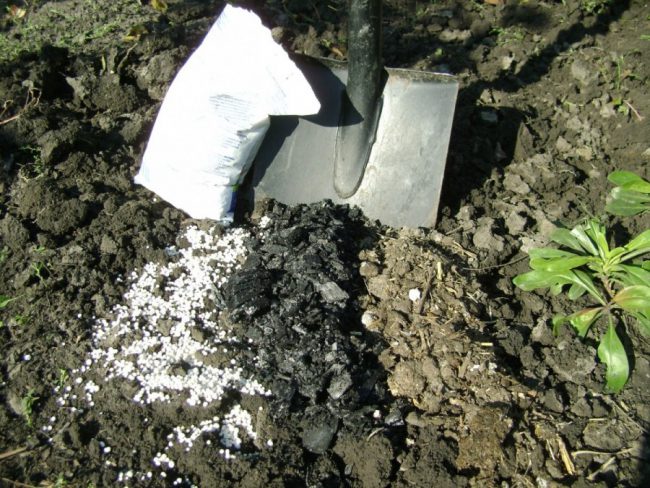
Manure has no odor and is a small white beads, readily soluble in water. In the sale of urea normally supplied in sealed plastic bags in the packaging kilogram.
How to apply urea
Urea can be used to fertilize all the plants in the garden, and garden. As used urea:
- Processing granules - shallowly granulated tablets are introduced into the soil;
- Introduction of the solution - Urea is dissolved in water and this lineup watered the soil around the plant and the roots;
- Foliar spraying - fertilizer dissolved in water sprayed all plants.
The most common way is spreading dry granules - so farmers are, with large areas of land. However, this method will not result, if it is not adjusted to the weather conditions.
I.e, if in the next couple of days after the treatment starts to rain, the fertilizer reaches the ground. But outdoors, without a deep contact with soil, Urea quickly lose their properties. Therefore it is better to granules mixed with ground, making them at least 4-7 cm under the ground.
Foliar fertilizer is best done in the dry, windless weather, without precipitation (but better - right after the rain), the nitrogen quickly penetrated into deep layers of the soil.
note! During sowing urea is best used in conjunction with potassium fertilizers, this helps to avoid the negative impacts of ammonia gas. The quantity of urea in the solution must be reduced by one-third.
Fertilizing plants through three approaches:
- Presowing - the granules are introduced at the spring plowed at a depth not less than 4 cm.
- Fertilizing at planting time - between seed (seeds) and fertilizer (granulated) It should be a layer of earth, you can not prevent them from mixing.
- Treatment during the growing season - produced spraying plants with a solution of urea.
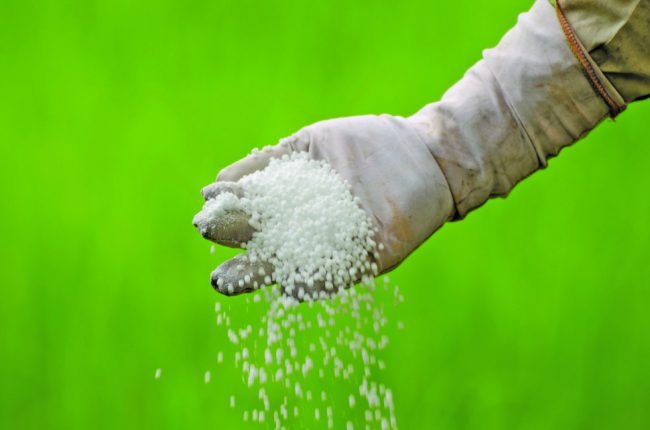
The usual dosage for breeding urea solution - 9-15 desyatilitrovoe grams per bucket of water (this amount is enough for about 20 square meters of flower beds). But to accurately calculate the proportion is set to plant species, which is scheduled treatment: eg, for herbaceous plants apply gentle makeup, for shrubs and trees - concentrated.
Important! urea content: in a tablespoon - 10-12 gram, in tea - 3-4 g, in a matchbox - 13-15 g.
The best time to introduce urea in the kidney is the flowering garden crops, and the period before the fruiting of plants for garden. It was at this time, you can identify the signs of nitrogen deficiency is most clearly.
note! Main fertilization usually takes place in April-May, as periodic feedings - in June-August.
In autumn fertilization to the ground will not give the desired effect, tk. at this point the microorganisms begin to decompose, and destruction occurs allocated organics. In the autumn of urea can be applied only in the case, if there is not too dry and warm weather.
How to handle different urea plant
amount of fertilizer, treatment period, methods of application of urea depend on the type of plant, phase of their growth and maturation, climatic zones and soil characteristics.
Fruit trees and shrubs
Fruit trees usually feed three times per season: when the first spring greenery, at flowering and during fruit ripening.
For each tree species has its own dosage (in granules):
- For young yablonek and pears - 150 g;
- Young cherries, plum and berry bushes - 70 g;
- For fruiting yablonek and pears - 200-250 g;
- For fruiting cherries and plums - 120-140 g;
- for strawberries (when will the ovary) - grout: 10 r into two liters of water.
In the treatment of urea fruit trees need to consider the following:
- Fertilizer into the soil should be applied in early spring after the first heavy rainfall.
- The soil should be thawed and sufficiently hydrated, to allow easy penetration into the soil nitrogen.
- Urea is desirable to extend under the tree canopy,, to the shadow of the foliage fertilizer protected from rapid decay. To do this, pull back about half a meter from the trunk.
- Together with urea is not necessary to use other nitrogenous fertilizers.
Important! The granules in the dry state should be entered in the ground at a shallow depth, top lightly sprinkled with ground.
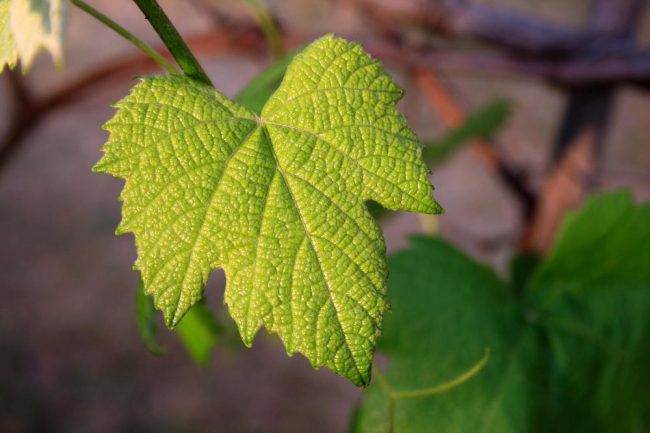
In order to protect next year's fruit plants from disease, You can spray the trees with a solution of urea during leaf fall.
vegetable crops
Vegetable fertilizer urea is usually used once per season - before ripening.
How to fertilize vegetables:
- Garlic, bow. The fertilizer is introduced into the growing season root method. Urea is recommended to mix with potassium chloride: by 10 g of urea and the same amount of potassium chloride for ten liters of water.
- tomatoes, pepper. As well, during the planting placed pellets (15 g).
- cucumbers, peas, beans. In the growing season, a solution for irrigation - 15 g desyatilitrovoe water bucket.
- Potatoes. Before planting into the soil placed pellets: 2 kg urea per hundred part portion.
- Cabbage, beet, carrot. The growing season is carried root feeding urea solution (on 10 liters of water 30 g fertilizer).
- courgettes, squash, Eggplant - the growing season to make the granules into the soil at the rate of 10-12 d of 1 square meter.
Important! Divorced of urea in the ground only after the pre-treatment - must be lightly broken into the ground around the root, pour fertilizer and loosen the soil with a rake.
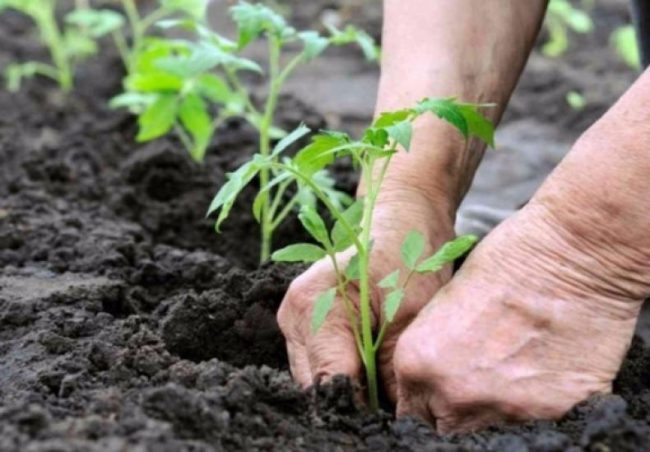
fertilizing plants in the greenhouse is carried out in the same manner and in the same dosages.
flowers
flowers, growing on open ground, treated with a solution of an organic compound of calculation 3-4 grams per square meter. Make fertilizer needed during growth, as the overly rapid growth of leaves can interfere with the normal budding.
Potted flowers and plants are sprayed with a solution of: on 10 liters of water 50-80 g fertilizer.
Urea from pests and diseases
Nitrogen fertilizer is used not only for the maintenance of plants, but also to fight against diseases and parasites:
- For pest control (tli, dolgonosikov, smooth snake, apple blossom beetle) spend processing plants in the early spring, When at temperature +5-7 degrees. Spraying is carried out only on the bare branches, ie the need to treat all plants, while not "woke up" the kidneys. On 10 liters of water taken approximately 500-700 grams of organic fertilizers (the solution should be well concentrated).
- For disease prevention. In November, the First, autumn, urea solution can be treated trees and shrubs, which are seen signs of infectious diseases (scab, rust, blotch, et al.). You need to spray the entire crown and leaf fertilizer opavshuyu five percent solution (about 1-5 liters per plant).
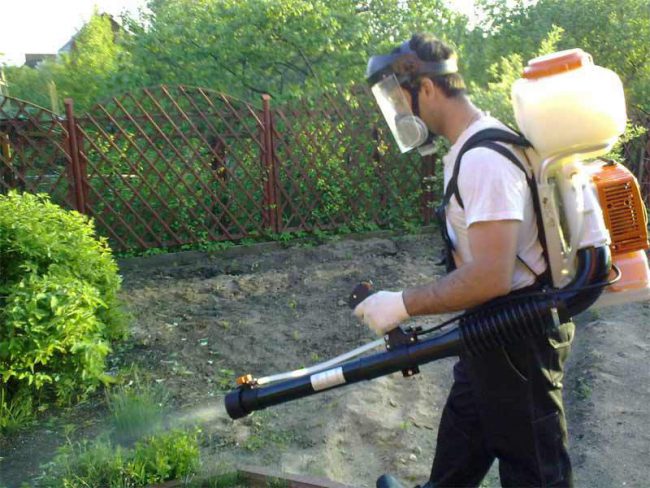
Autumn foliar treatment will help prevent disease, will give "live" for the winter in the plant pests and provide additional nitrogen fertilizer plants.
Pros and cons of treatment with urea
The benefits of the use of urea is confirmed by many gardeners and gardeners - a good harvest, get rid of pests and diseases. But, as well as any fertilizer, Urea has its drawbacks, that should be considered when applying the organic substance.
pros:
- It is the most nitrogen-containing fertilizer (46% nitrogen).
- Easily mixed with other fertilizers and soluble in liquid.
- It enriches the soil with essential trace elements.
- Affordable.
- Urea does not penetrate into the deeper layers of the soil and is rapidly degraded.
- Processing fertilizer does not cause burns leaves, that is considered to be quite gentle fertilizer.
- Easy and simple to use.
The disadvantages include the following fertilizer quality:
- nitrogen overdose leads to reduction of yield.
- It reduces the acidity in the soil.
- Quickly washed away by precipitation and dissolved by sunlight.
- It has a short shelf life, easily deteriorates.
Despite its shortcomings, Urea is the best of nitrogen fertilizers. With proper use of urea will not harm the plants and provide a good yield.
Tips
To the use of urea produced results, you need to clearly follow the instructions for use, and guided by the advice of experienced gardeners:
- Store the package with the granules in dry, since they are very quickly absorb the liquid and lumps.
- Do not connect the urea pushonka, superphosphate, dolomite powder, saltpeter, chalk.
- With other fertilizer urea connect directly before making, or preparing a solution.
- urea granules necessarily cover the top of the dry soil and incorporated into the soil at least 7-8 cm.
- Late fertilizing may adversely affect the crop, therefore, the target plants time, before, it will begin to bloom.
- Vnutrikornevuyu fertilizing fruit plants produce immediately after flowering, vegetable plants - before flowering and during fruit brandy.
- processing plants can not be done during the harvest season. Watering or spraying the latter made no later than, than 15-20 days before the harvest.
- For plant growth fertilizers are applied in early autumn, for prevention of pests and diseases - the first leaf fall.
Urea is considered the most effective fertilizer for gardening and gardens. If the correct approach to the treatment of urea plant and follow the pattern of application of nitrogen fertilization, the result will be - the correct plant growth and high yield.



